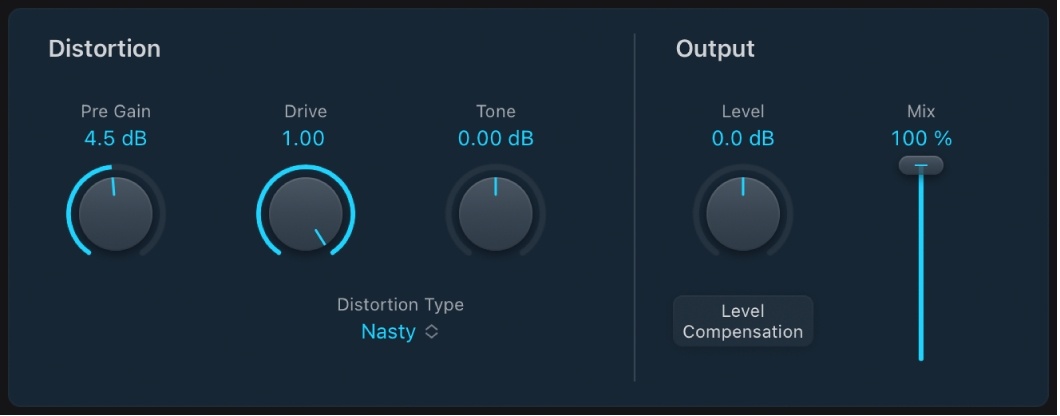Logic Pro User Guide for iPad
-
- What is Logic Pro?
- Working areas
- Work with function buttons
- Work with numeric values
-
- Intro to tracks
- Create tracks
- Create tracks using drag and drop
- Choose the default region type for a software instrument track
- Select tracks
- Duplicate tracks
- Reorder tracks
- Rename tracks
- Change track icons
- Change track colors
- Use the tuner on an audio track
- Show the output track in the Tracks area
- Delete tracks
- Edit track parameters
- Start a Logic Pro subscription
- How to get help
-
- Intro to recording
-
- Before recording software instruments
- Record software instruments
- Record additional software instrument takes
- Record to multiple software instrument tracks
- Record multiple MIDI devices to multiple tracks
- Record software instruments and audio simultaneously
- Merge software instrument recordings
- Spot erase software instrument recordings
- Replace software instrument recordings
- Capture your most recent MIDI performance
- Use the metronome
- Use the count-in
-
- Intro to arranging
-
- Intro to regions
- Select regions
- Cut, copy, and paste regions
- Move regions
- Remove gaps between regions
- Delay region playback
- Trim regions
- Loop regions
- Repeat regions
- Mute regions
- Split and join regions
- Stretch regions
- Separate a MIDI region by note pitch
- Bounce regions in place
- Change the gain of audio regions
- Create regions in the Tracks area
- Convert a MIDI region to a Drummer region or a pattern region
- Rename regions
- Change the color of regions
- Delete regions
- Create fades on audio regions
- Access mixing functions using the Fader
-
- Intro to Step Sequencer
- Use Step Sequencer with Drum Machine Designer
- Record Step Sequencer patterns live
- Step record Step Sequencer patterns
- Load and save patterns
- Modify pattern playback
- Edit steps
- Edit rows
- Edit Step Sequencer pattern, row, and step settings in the inspector
- Customize Step Sequencer
-
- Effect plug-ins overview
-
- Instrument plug-ins overview
-
- ES2 overview
- Interface overview
-
- Modulation overview
-
- Vector Envelope overview
- Use Vector Envelope points
- Use Vector Envelope solo and sustain points
- Set Vector Envelope segment times
- Vector Envelope XY pad controls
- Vector Envelope Actions menu
- Vector Envelope loop controls
- Vector Envelope release phase behavior
- Vector Envelope point transition shapes
- Use Vector Envelope time scaling
- Use the Mod Pad
- Modulation source reference
- Via modulation source reference
-
- Sample Alchemy overview
- Interface overview
- Add source material
- Save a preset
- Edit mode
- Play modes
- Source overview
- Synthesis modes
- Granular controls
- Additive effects
- Additive effect controls
- Spectral effect
- Spectral effect controls
- Filter module
- Low and Highpass filter
- Comb PM filter
- Downsampler filter
- FM filter
- Envelope generators
- Mod Matrix
- Modulation routing
- Motion mode
- Trim mode
- More menu
- Sampler
- Copyright
Distortion II in Logic Pro for iPad
Distortion II emulates the distortion circuit of a Hammond B3 organ. You can use it on musical instruments to recreate this classic effect or can use it creatively when designing new sounds.
To add Distortion II to your project, choose Distortion > Distortion II in a channel strip Audio Effect plug-in menu or the Plug-ins area. See Intro to plug-ins. Also see Add, replace, reorder, and remove plug-ins in the Plug-ins area and Work with plug-ins in the Mixer.

Distortion II parameters
Pre Gain knob and field: Set the amount of gain applied to the input signal.
 Drive knob and field: Set the amount of saturation applied to the signal.
Drive knob and field: Set the amount of saturation applied to the signal. Tone knob and field: Boosts the integrated high shelf filter gain both pre- and post-distortion, which results in a different tone.
Tone knob and field: Boosts the integrated high shelf filter gain both pre- and post-distortion, which results in a different tone. Distortion Type pop-up menu: Choose the type of distortion.
Distortion Type pop-up menu: Choose the type of distortion.Growl: Emulates a two-stage tube amplifier similar to the type found in a Leslie 122 speaker cabinet, which is often used with the Hammond B3 organ.
Bity: Emulates the sound of a bluesy (overdriven) guitar amp.
Nasty: Produces hard distortion, suitable for creating very aggressive sounds.
Class AB soft: Emulates a softer crossover distortion encountered in transistorized amplifiers when driving a higher load.
Class AB hard: Emulates a harder crossover distortion encountered in transistorized amplifiers when driving a higher load.
Crossover, in this case, refers to a switching between two matched transistors. In Class AB designs, both transistors remain on at all times, reducing the effect of hard switching between them.
Level slider and field: Set the amount of gain applied to the plug-in output stage.
Mix knob and field: Set the ratio between the effect (wet) signal and original (dry) signals, following the clip filter.
Download this guide: PDF